Meijer Pregnancy Test
Reliable Results in Minutes
Meijer offers a range of pregnancy tests to meet various needs and preferences. These tests provide women with a convenient way to check for pregnancy from the comfort of home.
Meijer's pregnancy test options include digital tests with smart countdown features and rapid detection tests for quick results. The retailer stocks well-known brands like Clearblue, offering value packs that combine different test types.
Pricing and availability of pregnancy tests at Meijer may vary by location and online. The store frequently runs promotions and offers digital coupons through their mPerks program, allowing customers to save on these essential products. Meijer aims to provide accessible and affordable options for those seeking to confirm a potential pregnancy.
Understanding Pregnancy Tests
Pregnancy tests detect the hormone hCG to determine if a woman is pregnant. These tests come in different forms and vary in sensitivity and accuracy.
The Basics of Pregnancy Tests
Pregnancy tests work by detecting human chorionic gonadotropin (hCG) in urine or blood. This hormone is produced shortly after a fertilized egg attaches to the uterine wall. Most tests can detect hCG as early as 10-14 days after conception.
Test sensitivity varies between brands. Some claim to detect pregnancy up to 6 days before a missed period, while others are most accurate from the first day of a missed period.
To ensure accuracy, it's best to:
Follow instructions carefully
Use first-morning urine
Wait until after a missed period to test
Confirm results with a healthcare provider
Types of Pregnancy Tests
Two main types of pregnancy tests are available: urine tests and blood tests.
Urine tests:
Most common and widely used
Can be done at home
Provide quick results (usually within minutes)
Generally 97% accurate when used correctly
Blood tests:
Conducted at medical facilities
More sensitive than urine tests
Can detect pregnancy earlier
Two types: qualitative (detects presence of hCG) and quantitative (measures hCG levels)
Digital tests offer clear "pregnant" or "not pregnant" results, reducing interpretation errors. However, they tend to be more expensive than traditional line tests.
Meijer Pregnancy Test Features
Meijer offers pregnancy tests with varying features to meet different needs. These tests provide options in terms of sensitivity and display types.
Test Sensitivity
Meijer pregnancy tests are designed to detect human chorionic gonadotropin (hCG), the hormone produced during pregnancy. Some Meijer tests can detect pregnancy as early as 5 days before a missed period. This high sensitivity allows for earlier detection, giving users quicker results.
The sensitivity of Meijer tests can vary between products. Early result tests typically have higher sensitivity, detecting lower levels of hCG. Standard tests may require higher hormone levels for a positive result.
It's important to note that test accuracy improves the closer it's taken to the expected period date. False negatives are more common with early testing.
Digital vs. Standard Tests
Meijer offers both digital and standard pregnancy tests. Digital tests provide results in words, typically displaying "Pregnant" or "Not Pregnant" on a screen. This eliminates the need to interpret lines, reducing user error.
Standard tests use lines to indicate results. A single line usually means negative, while two lines indicate a positive result. These tests are often more affordable and come in multi-packs.
Digital tests from Meijer may include features like result timers or week estimators. Standard tests are simpler but equally accurate when used correctly. The choice between digital and standard often comes down to personal preference and budget considerations.
How to Use a Pregnancy Test
Pregnancy tests are simple yet powerful tools for detecting early pregnancy. Proper usage and result interpretation are crucial for accurate results.
Before Taking the Test
Choose a time when your urine is most concentrated, typically first thing in the morning. Wash your hands thoroughly. Open the test package and remove the test stick. Some tests require urinating directly on the absorbent tip, while others involve collecting urine in a clean cup.
For direct testing, remove the cap and hold the absorbent end in your urine stream for 5-10 seconds. If using a cup, dip the test stick into the urine for the time specified in the instructions.
Place the test on a flat surface with the result window facing up. Set a timer according to the package directions, usually 3-5 minutes.
Interpreting Results
Read the results within the timeframe specified by the manufacturer. Most tests display two lines or symbols:
Control line: Confirms the test is working properly
Test line: Indicates pregnancy status
A visible test line, even if faint, typically indicates a positive result. The absence of a test line usually means a negative result.
Positive Result: Two lines appear Negative Result: Only the control line is visible
If no lines appear or only the test line shows, the test may be faulty. Repeat with a new test. For unclear results or health concerns, consult a healthcare provider.
Addressing Common Concerns
Pregnancy tests can bring up many questions and uncertainties. Understanding when to take the test, interpreting faint lines, and being aware of potential errors are crucial for accurate results.
When to Take the Test
The best time to take a Meijer pregnancy test is after a missed period. This allows time for hCG levels to build up in the body. For most accurate results, use first morning urine when hCG concentration is highest.
Some tests claim to detect pregnancy earlier, but waiting until after a missed period reduces false negatives. Ovulation typically occurs about 14 days before the next expected period. Testing too early may lead to disappointment or confusion.
If irregular periods are an issue, wait at least 21 days after possible conception before testing. Repeat the test a few days later if the result is negative but pregnancy is still suspected.
Understanding Faint Lines
Faint lines on pregnancy tests can be confusing. A faint line that appears within the test's time frame is usually considered positive. The intensity of the line doesn't necessarily indicate the strength of the pregnancy.
Factors affecting line darkness:
Time of day
Urine concentration
Stage of pregnancy
Test again in a few days if unsure. The line should become darker as hCG levels increase. Digital tests can help eliminate confusion by displaying clear "pregnant" or "not pregnant" results.
Potential Errors and Accuracy
Meijer pregnancy tests are highly accurate when used correctly. However, errors can occur. Common causes of false results include:
Expired tests
Incorrect usage
Testing too early
Certain medications
False positives are rare but can happen due to:
Recent pregnancy loss
Some fertility treatments
Certain medical conditions
To ensure accuracy:
Check expiration date
Follow instructions carefully
Use first morning urine
Wait full time before reading results
If results are unexpected or unclear, consult a healthcare provider for confirmation and guidance.
Beyond the Test
A positive pregnancy test marks the start of an important journey. Accurate next steps and reliable support resources are crucial for expectant parents.
Next Steps after a Positive Result
Schedule an appointment with a healthcare provider as soon as possible. They will confirm the pregnancy and estimate the due date. The doctor may order blood tests and an ultrasound to check the baby's health and development.
Start taking prenatal vitamins with folic acid. These support fetal growth and help prevent certain birth defects. Quit smoking, drinking alcohol, and using drugs if applicable.
Review current medications with a doctor to ensure they're safe during pregnancy. Begin making lifestyle changes like eating a balanced diet and getting regular exercise.
Consider sharing the news with trusted family and friends for emotional support.
Pregnancy Resources and Support
Local health departments often offer free or low-cost prenatal care programs. These can include nutrition counseling, childbirth classes, and breastfeeding support.
Online forums and apps provide communities for expectant parents to share experiences and advice. Reputable websites like the American Pregnancy Association offer evidence-based information on fetal development and pregnancy health.
Many hospitals host tours of their maternity wards and offer prenatal classes. These can help parents prepare for labor, delivery, and newborn care.
Parenting books and magazines can be valuable resources for learning about pregnancy and early childcare. Local libraries often have extensive collections on these topics.
Choosing the Right Pregnancy Test
Selecting an appropriate pregnancy test involves considering accuracy, ease of use, and personal preferences. Different brands and models offer various features to meet diverse needs.
Comparing Brands and Models
Meijer offers a range of pregnancy test options, including basic test strips and digital tests. Digital tests typically provide clearer results with words like "Pregnant" or "Not Pregnant" displayed on a screen. Strip tests use lines to indicate results and may be more affordable.
Some tests can detect pregnancy earlier than others. First Response Early Result claims to detect pregnancy up to 6 days before a missed period. Clearblue Rapid Detection provides quick results in as little as 1 minute.
Sensitivity levels vary between tests. More sensitive tests can detect lower levels of hCG hormone, potentially giving earlier results. Consider your preferences for result display, testing window, and ease of interpretation when choosing.
Cost and Availability
Pregnancy test prices vary widely. Basic strip tests are often the most economical option, especially when purchased in bulk. Digital tests and those with plastic handles tend to be more expensive.
Meijer stores typically stock a variety of pregnancy test brands and models. Prices may differ between locations and online. Look for promotions or coupons to save on your purchase.
Consider how many tests you need. Multi-packs can offer better value if you plan to test multiple times. Some women prefer to buy a mix of different test types for confirmation.
Keep in mind that more expensive tests don't necessarily mean more accurate results. FDA regulations ensure all over-the-counter pregnancy tests meet certain accuracy standards when used correctly.








